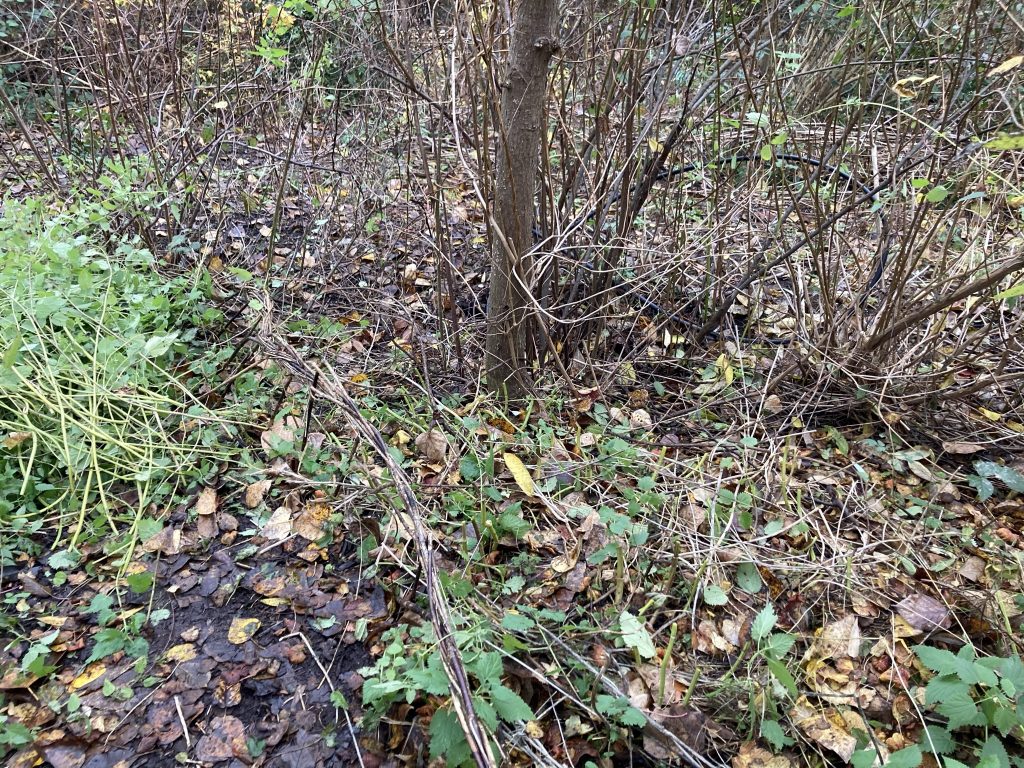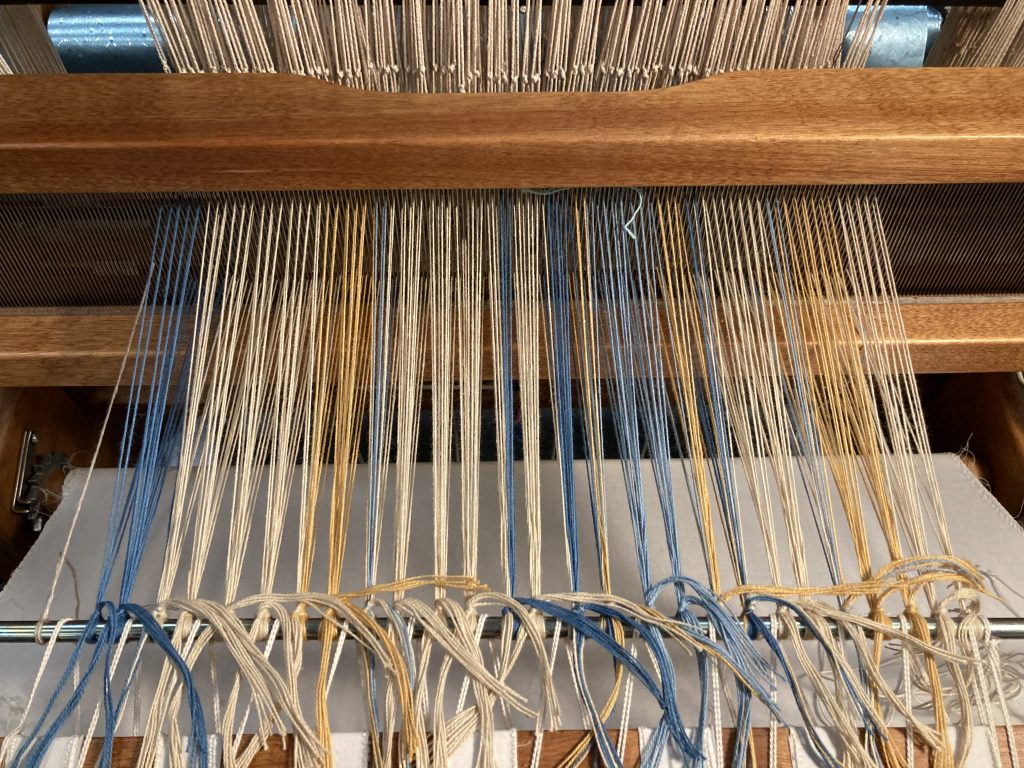Pulling It Together
Ever feel like it’s all getting to be too much? This was a grind of a week. I tried to pull it all back together by going through and trying to organize all the stuff around my desk, deciding what should go to the school studio and what needed to find a place at home… Nomi clearly was unimpressed. Bill was pretty skeptical: “how long are you going to leave it like this?” Sometimes you gotta make a mess to get organized. Or at least that is what I tell myself. Apologies to those of you who have organization figured out and are horrified by my process. Please cover your eyes.
Threading the Heddles
I was hoping to have the loom ready to go by the end of last week, but just preparing the warp, and attaching it to the back beam took up all of last week. It worked out well though because I was able to take a bit more time thinking about what pattern I would use going through the heddles. I went through the reference books and found some really beautiful options, but decided on a simple twill pattern, which basically means over two under two. I think that’s the pattern they use to make jeans. The Dorset loom is a direct tie-up (don’t worry if this doesn’t make sense) so that meant simply going 4,3,2,1, 4,3,2,1, 4,3,2,1, etc. I had started working with the number 12 when I was making the warp, so the pattern of four was easily divisible into the pattern. I have never been particularly good at counting or match, I get distracted easily, and always write the numbers in the wrong order, but I am good at patterns, proportions and fractions. The spatial part of math. The patterns made sense, even if I could barely remember what Aunt Norma had shown us, it felt really natural to move from intension into the framework offered up by the floor loom. It also made me think of playing the piano: 4,3,2,1 4,3,2,1 4,3,2,1. I could hear the arpeggio in my head as I pulled the threads through.
One of the other pleasures of this task was that my hands were busy, but my ears, voice and mind were available for engagement. Over the week I spent approx. 20 hrs. listening to podcasts, and chatted with my mom over video calls. The phone rested on the top of the loom with the camera pointing down at my hands as I worked, and the screen facing up so I could see my mom on the other end of the call. Our longest conversation was 4 hours long. I have a feeling that these kinds of conversations will be a part of my work moving forward. I also spent some time working at the Modes of Production garden in North China Creek Park harvesting nettles. I am hoping to learn how to turn the nettle into fibres I can work with in addition to the flax fibres, which I realized this week I have over retted. I will try to salvage what I can, but it looks like I have to wait until next summer before I can harvest the flax. It’s a pretty big disappointment. I was hoping I would get to making some cloth with the linen this semester. I have been thinking a lot about time scales the past few months. Especially in terms of learning and unlearning colonial ways of being. Industry drives us as designers to be working on quarterly times scales, the school has us working on a semester system of time, but the flax gets harvested in the summer. It’s on a yearly scale. So with this failure, I will have to wait, and adjust my expectations and framing of time to match the seasons of the plant. It isn’t that bad to wait. I can work on weaving, dyeing, harvesting and processing other fibres, planting and growing, composting. There is something available and in season right now, and plenty to learn.
Slaying the Reed
The next step was pulling the threads through the reed. I had some math problems here, I was trying to figure out how dense I wanted the cloth to be, and how wide I wanted the cloth to be. It was all somewhat arbitrary because I skipped the first step Aunt Norma had drilled into my mom and I when we attended her weaving boot camp. Dear Aunt Norma, if you are reading this, I apologize. You taught us how to measure our materials, to record our threads per inch, and weigh our materials so we could calculate how long to make our warps and how to use our materials as efficiently as possible. I skipped that step. I got excited. I wanted to see how much I could remember, so I just went for it. The table legs I made my warp on determined the length of my cloth, and I figured if I was using a 12 dent reed, I could do two threads per dent, getting 24 threads per inch. With shrinkage, I figured I’d get a cloth that would be about 6 inches wide, and that I could use the cloth to make nice little fanny packs and pouches that were around 5.5×8 inches. While I worked I regretted this, because I realized it would have been more efficient to make a wider cloth. Fortunately this all worked out, because I counted wrong at some point and I actually had 312 threads instead of 156. So I ended up with 13 inches sleyed through the reed, which would shrink down to 11-12 inches. Maybe I’ll have to make side bags instead of fanny packs… I probably should have done a better job planning. Next time Aunt Norma! That being said, with every mistake I make – and I make at least one mistake on pretty much every step – I am learning how to recover and adapt, and what the meaning is behind each step. With each mistake, I begin to understand the loom better. We are getting to know each other better me and the Dorset loom, and I am also getting to know my cloth really well, every step requires a decision, and every decision starts to shape the outcome of the cloth. There are so many variables and opportunities, that I can see a lifetime of exploration stretch out before me. I think Aunt Norma will be proud that she passed her craft down to me.
Tying On
I was really excited to do this part because tying on means you have dressed the loom. The warp is on and you are one step away from actually weaving. My mom wasn’t kidding, weaving is the 10th or 11th step of making cloth. Not to mention the steps of harvesting fibre, all the steps to process and spin the fibre into thread, and all the steps that go into dying a fibre. It blows my mind that you can buy a sweater for $20 at the mall. It doesn’t quite add up, does it? Tying up is a pretty important step, it doesn’t take very long to do 20 min for a beginner like myself, if you do it well you will have good even tension throughout your cloth, if you do it poorly it will show up in the final product, or you will try to compensate in how you through your weft. So I went home and went to bed. It’s a good thing I did it was late that night, but after I finished the tie-up I discovered a mistake in how I sleyed the reed, two threads were crossed, so they sheds wouldn’t open, so I had to undo it and retie it again, that took more like 40 min to fix, so I was happy that I started fresh after a good nights sleep. Good thing too, because – spoiler alert! – I found one more mistake…

Taking Out the Lease Sticks
So finally after 3 weeks of preparing, and 3 weeks of mistakes, I am ready to take out the lease sticks, to begin throwing the weft, and to become a weaver. Finally!! So I grab some scrap yarn and start weaving a plain cloth pattern, 1 over 1, and that’s when I spot it. Another mistake. In around the middle of the cloth. For two dents in a row, I put only one thread per dent. and you can see the effect in the cloth, I had originally planned to have some spaced single and some spaced double, but that was before I realized my cloth was going to be 12 inches wide. I didn’t want it to get any wider. I also wanted the colours of the warp to come forward. You can see in the photos, that where I made the error, the black weft was coming forward more. On that third tie-up, I decided to only re-tie half. Bill was waiting for me at home, and friends were dropping by with a surprise, so I had to rush. The surprise was freshly harvested chanterelle mushrooms!!!!! I have no regrets, but now the left side is tighter than the right side, and I won’t know until I remove the cloth from the loom what effect that will have. This left me thinking about how every action leaves a mark, visible or invisible, the twists and tensions have an effect. It makes me think about people, how we interact with one another. I wonder how many marks I have made, and what marks people left on me that are still reverberating.
Can you see the error? Two little threads misspaced. Part of me wishes I just left it. The other part of me is glad I went back for the correction. On the next project, I definitely want to explore different spacings in the dents, I really like how it changes the emphasis from warp to weft.


























